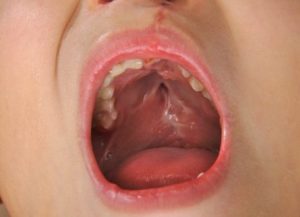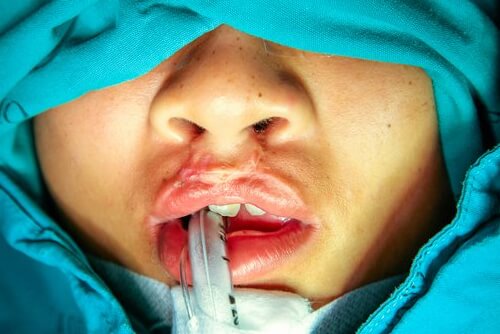Children with a Cleft Palate: Everything You Need to Know

Our palate, the rigid area at the top of our mouths, can develop with various malformations. The most common of these is a palate fissure or cleft palate.
This congenital defect can lead to difficulty eating and drinking. It’s often confused with a cleft lip, as both conditions develop early in pregnancy, but they aren’t the same thing.
A cleft palate and cleft lip can occur separately or together. The former is a direct fissure in the palate which extends up to the nose.
The latter is an opening from the top lip to the nostrils. Both conditions require surgery to correct the defect and avoid complications.
What causes a cleft palate?
This anomaly affects around 1 in every 700 children. It occurs when the tissues that make up the lips and palate don’t join up correctly.
Both genetics and environmental factors can influence it. Mutations have been discovered in genes which are susceptible to damage from tobacco, alcohol and vitamin deficiencies.
Family history is also relevant, as is taking certain medication. Drugs associated with a higher risk of cleft palate include those used to treat convulsions, cancer, arthritis and acne.
Doctors haven’t ruled out the possibility that exposure to certain chemical agents or viruses may also trigger alterations of this type.
There are around 350 syndromes that are known to cause this defect, among other clinical symptoms.
One of these is Van der Wouder syndrome (VWS), which is associated with an alteration in genes IRF6 and GRHL3.
If the variant form of the gene associated with this syndrome has been identified in the family, prenatal diagnosis may be possible.

Diagnosing a cleft palate
If the upper jaw doesn’t fully fuse during pregnancy, a fissure may remain in the top of the child’s mouth. This is what we call a cleft palate.
The “cleft” may appear in the hard palate at the front of the mouth, or the softer tissue towards the throat (soft palate).
It may even extend into the nasal cavity or affect the lips.
Unlike a cleft lip, this condition can be difficult to detect during pregnancy and doesn’t show up on ultrasound scans.
This means that doctors aren’t aware of a cleft palate until the baby is born.
The fissure may be very small, or may form a large hole that causes difficulty breathing, feeding and communicating.
The most pressing problem in babies with a cleft palate is their inability to create a vacuum inside their mouth to facilitate suction.
The milk they drink can come out through their nose, causing them to spit up and increasing the risk of asphyxiation.
With this in mind, parents of babies with a cleft palate should use a special bottle to feed them, and operate as soon as possible
Complications associated with a cleft palate
A child with a cleft palate is vulnerable to chronic ear infections and may have difficulty communicating.
These complications often give rise to emotional and psychological conflicts.
If this is the case, a child psychologist can help address the underlying issues.
If the fissure extends to the lip, the defect is visible. This type of cleft palate may also affect dental health, making the child’s teeth crooked and prone to cavities.
Additionally, it may affect the shape of the nose.

“The most pressing problem in babies with a cleft palate is their inability to create a vacuum inside their mouth to facilitate suction”
Despite all of this, it’s important to keep in mind that a cleft palate is not a disease.
With the proper care, children born with a cleft palate are able to lead a normal life.
Until the child has corrective surgery, it’s important to keep them in a tilted position. This ensures they can always clear their nose and aren’t at risk of choking if they vomit.
Surgery to correct a cleft palate
Corrective surgery for children with a cleft palate is a delicate process.
While cleft lips can normally be operated on by the time the baby is three months old, cleft palate surgery is often left until after their first birthday.
Depending on the severity of the defect, the number and type of surgeries necessary can vary.
“With the proper care, children born with a cleft palate are able to lead a normal life”
In general, surgeons will need to close up the hard and soft palate, correct the structure of the lips and nose, fill in spaces in the gums, form bone structures and carry out aesthetic procedures.
This can be a long process that requires a great deal of patience.
It’s not always possible to close the fissure completely. If this is the case, doctors often suggest using a dental prothesis to make it easier to eat.
Is it possible to prevent a cleft palate? Adopting healthy habits during pregnancy and taking vitamins (folic acid and vitamin A) can help.
However, since this is a congenital defect with multiple causes, it’s difficult to avoid. What is important for parents to understand is this isn’t a severe condition, and solutions are available.
Our palate, the rigid area at the top of our mouths, can develop with various malformations. The most common of these is a palate fissure or cleft palate.
This congenital defect can lead to difficulty eating and drinking. It’s often confused with a cleft lip, as both conditions develop early in pregnancy, but they aren’t the same thing.
A cleft palate and cleft lip can occur separately or together. The former is a direct fissure in the palate which extends up to the nose.
The latter is an opening from the top lip to the nostrils. Both conditions require surgery to correct the defect and avoid complications.
What causes a cleft palate?
This anomaly affects around 1 in every 700 children. It occurs when the tissues that make up the lips and palate don’t join up correctly.
Both genetics and environmental factors can influence it. Mutations have been discovered in genes which are susceptible to damage from tobacco, alcohol and vitamin deficiencies.
Family history is also relevant, as is taking certain medication. Drugs associated with a higher risk of cleft palate include those used to treat convulsions, cancer, arthritis and acne.
Doctors haven’t ruled out the possibility that exposure to certain chemical agents or viruses may also trigger alterations of this type.
There are around 350 syndromes that are known to cause this defect, among other clinical symptoms.
One of these is Van der Wouder syndrome (VWS), which is associated with an alteration in genes IRF6 and GRHL3.
If the variant form of the gene associated with this syndrome has been identified in the family, prenatal diagnosis may be possible.

Diagnosing a cleft palate
If the upper jaw doesn’t fully fuse during pregnancy, a fissure may remain in the top of the child’s mouth. This is what we call a cleft palate.
The “cleft” may appear in the hard palate at the front of the mouth, or the softer tissue towards the throat (soft palate).
It may even extend into the nasal cavity or affect the lips.
Unlike a cleft lip, this condition can be difficult to detect during pregnancy and doesn’t show up on ultrasound scans.
This means that doctors aren’t aware of a cleft palate until the baby is born.
The fissure may be very small, or may form a large hole that causes difficulty breathing, feeding and communicating.
The most pressing problem in babies with a cleft palate is their inability to create a vacuum inside their mouth to facilitate suction.
The milk they drink can come out through their nose, causing them to spit up and increasing the risk of asphyxiation.
With this in mind, parents of babies with a cleft palate should use a special bottle to feed them, and operate as soon as possible
Complications associated with a cleft palate
A child with a cleft palate is vulnerable to chronic ear infections and may have difficulty communicating.
These complications often give rise to emotional and psychological conflicts.
If this is the case, a child psychologist can help address the underlying issues.
If the fissure extends to the lip, the defect is visible. This type of cleft palate may also affect dental health, making the child’s teeth crooked and prone to cavities.
Additionally, it may affect the shape of the nose.

“The most pressing problem in babies with a cleft palate is their inability to create a vacuum inside their mouth to facilitate suction”
Despite all of this, it’s important to keep in mind that a cleft palate is not a disease.
With the proper care, children born with a cleft palate are able to lead a normal life.
Until the child has corrective surgery, it’s important to keep them in a tilted position. This ensures they can always clear their nose and aren’t at risk of choking if they vomit.
Surgery to correct a cleft palate
Corrective surgery for children with a cleft palate is a delicate process.
While cleft lips can normally be operated on by the time the baby is three months old, cleft palate surgery is often left until after their first birthday.
Depending on the severity of the defect, the number and type of surgeries necessary can vary.
“With the proper care, children born with a cleft palate are able to lead a normal life”
In general, surgeons will need to close up the hard and soft palate, correct the structure of the lips and nose, fill in spaces in the gums, form bone structures and carry out aesthetic procedures.
This can be a long process that requires a great deal of patience.
It’s not always possible to close the fissure completely. If this is the case, doctors often suggest using a dental prothesis to make it easier to eat.
Is it possible to prevent a cleft palate? Adopting healthy habits during pregnancy and taking vitamins (folic acid and vitamin A) can help.
However, since this is a congenital defect with multiple causes, it’s difficult to avoid. What is important for parents to understand is this isn’t a severe condition, and solutions are available.
This text is provided for informational purposes only and does not replace consultation with a professional. If in doubt, consult your specialist.








